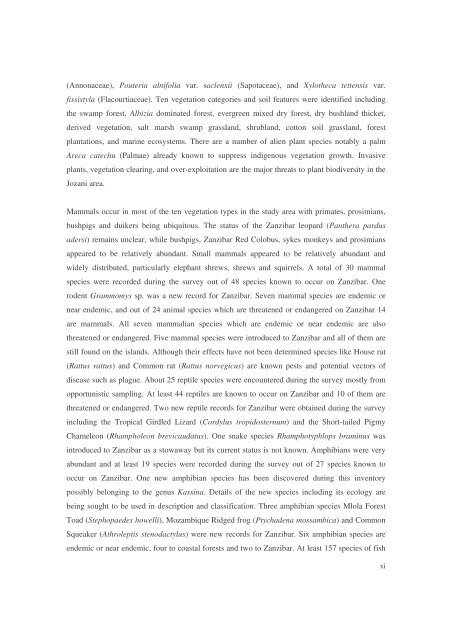Jozani biodiversity inventory report 2002 - Coastal Forests of Kenya ...
Jozani biodiversity inventory report 2002 - Coastal Forests of Kenya ...
Jozani biodiversity inventory report 2002 - Coastal Forests of Kenya ...
You also want an ePaper? Increase the reach of your titles
YUMPU automatically turns print PDFs into web optimized ePapers that Google loves.
(Annonaceae), Pouteria alnifolia var. saclenxii (Sapotaceae), and Xylotheca tettensis var.<br />
fissistyla (Flacourtiaceae). Ten vegetation categories and soil features were identified including<br />
the swamp forest, Albizia dominated forest, evergreen mixed dry forest, dry bushland thicket,<br />
derived vegetation, salt marsh swamp grassland, shrubland, cotton soil grassland, forest<br />
plantations, and marine ecosystems. There are a number <strong>of</strong> alien plant species notably a palm<br />
Areca catechu (Palmae) already known to suppress indigenous vegetation growth. Invasive<br />
plants, vegetation clearing, and over-exploitation are the major threats to plant <strong>biodiversity</strong> in the<br />
<strong>Jozani</strong> area.<br />
Mammals occur in most <strong>of</strong> the ten vegetation types in the study area with primates, prosimians,<br />
bushpigs and duikers being ubiquitous. The status <strong>of</strong> the Zanzibar leopard (Panthera pardus<br />
adersi) remains unclear, while bushpigs, Zanzibar Red Colobus, sykes monkeys and prosimians<br />
appeared to be relatively abundant. Small mammals appeared to be relatively abundant and<br />
widely distributed, particularly elephant shrews, shrews and squirrels. A total <strong>of</strong> 30 mammal<br />
species were recorded during the survey out <strong>of</strong> 48 species known to occur on Zanzibar. One<br />
rodent Grammomys sp. was a new record for Zanzibar. Seven mammal species are endemic or<br />
near endemic, and out <strong>of</strong> 24 animal species which are threatened or endangered on Zanzibar 14<br />
are mammals. All seven mammalian species which are endemic or near endemic are also<br />
threatened or endangered. Five mammal species were introduced to Zanzibar and all <strong>of</strong> them are<br />
still found on the islands. Although their effects have not been determined species like House rat<br />
(Rattus rattus) and Common rat (Rattus norvegicus) are known pests and potential vectors <strong>of</strong><br />
disease such as plague. About 25 reptile species were encountered during the survey mostly from<br />
opportunistic sampling. At least 44 reptiles are known to occur on Zanzibar and 10 <strong>of</strong> them are<br />
threatened or endangered. Two new reptile records for Zanzibar were obtained during the survey<br />
including the Tropical Girdled Lizard (Cordylus tropidosternum) and the Short-tailed Pigmy<br />
Chameleon (Rhampholeon brevicaudatus). One snake species Rhamphotyphlops braminus was<br />
introduced to Zanzibar as a stowaway but its current status is not known. Amphibians were very<br />
abundant and at least 19 species were recorded during the survey out <strong>of</strong> 27 species known to<br />
occur on Zanzibar. One new amphibian species has been discovered during this <strong>inventory</strong><br />
possibly belonging to the genus Kassina. Details <strong>of</strong> the new species including its ecology are<br />
being sought to be used in description and classification. Three amphibian species Mlola Forest<br />
Toad (Stephopaedes howelli), Mozambique Ridged frog (Ptychadena mossambica) and Common<br />
Squeaker (Athroleptis stenodactylus) were new records for Zanzibar. Six amphibian species are<br />
endemic or near endemic, four to coastal forests and two to Zanzibar. At least 157 species <strong>of</strong> fish<br />
xi
















